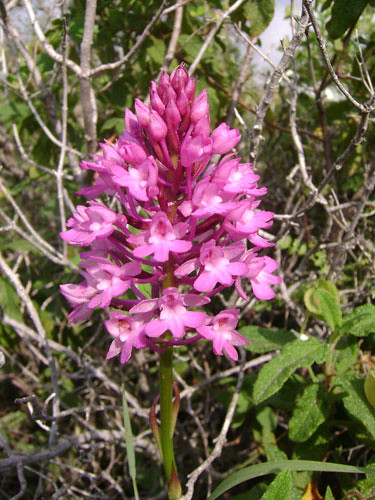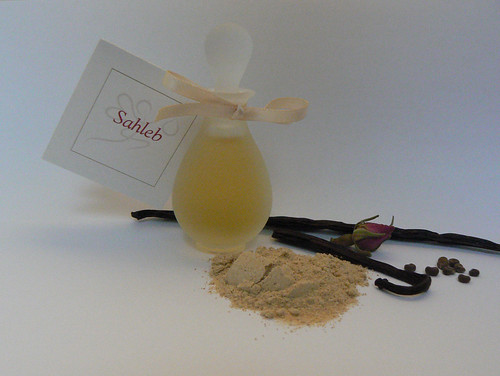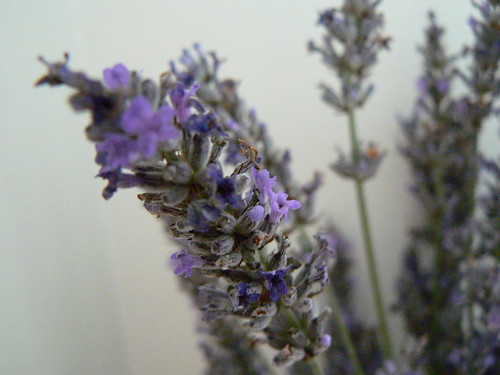Magnolia Lily & The Chinese Apothecary
No Brainer

Human brain - please add comment and fav this if you blog with it., originally uploaded by Gaetan Lee.
In the past few months, I have been feeling a writer's-resistance for writing about my experiences with perfumes. Blogging about perfumes and "reviewing" them for over 2 years has taught me a lot about perfume. But it also taught me that olfactory fatigue is not just a physical phenomenon; it is actually possible to beat the fun out of something you love by talking about it too much. And this is precisely what I have been trying to avoid recently by not writing perfume reviews for a long time, and instead - enjoying the many other aspects of perfumery, such as perfume creation itself; developing new scented products. My scented candles and sachets for the home have been a pleasure to work on and test and try at my own space; and scenting teas (and chocolates!) added another dimension to my life with quiet, peaceful rituals that I can appreciate alone or with friends.
I have spoken last year about a general fatigue that I'm sensing in the perfume world. New launches every day, loads of information online that could eat up a whole day in research, endless perfume blogs (and new ones that emerge quite often too). This abundance is great, but it also has its side effects.
"How much perfume knowledge is too much?" asks Angela of Now Smell This. And her question couldn't have been more relevant. I've been asking the same thing myself. While I can't say my knowledge even begins to scrape the surface of what a perfumer should know, the endless amount of perfume-related information that floods our brains is overwhelming. To the point that it might as well beat the fun out of it for some of us. And I'm afraid it has done just that, judging by the number of excellent perfume blogs that have been sitting stale with no blog entry for months and months on end (of course, there could be other reasons for not posting on a blog, but I still think there is a trend here).
In the past few months, I have stumbled upon very few new perfume (or new to me) that left with an urge to blog. I haven't even bothered trying any of the many new collections that were released recently (i.e.: Tom Ford's Private Blends). Obviously, I'm just feeling overwhelmed.
At the same time, I am enjoying wearing and making perfumes, sipping teas and cooking with aromatic spices and herbs, discovering new flavours I've never tried before, and experimenting with new combination of notes and flavours with much pleasure. Instead of trying a different perfume every day (I've done that over certain periods of my life before) I'm just enjoying a few that I really like, and coming back to old favourites. Instead of feeling pressure to write about whatever is shiny and new, I'm just enjoying the perfumes I already have and love.
At the same time, I'm also trying to un-learn my note-desection tendancies, and instead - just enjoy the fragrane as a whole. And nothing could be more appropriate to remedy this analytic disease than a very complex Chypre: chic, sophisticated, earthy, grounding, with subtle nuances and evolution that can never bore even the most experienced nose.
I've been coming back to my old and all-time favourites - Miss Dior, Femme (the vintage is so beautiful it makes me want to never cry again when I smell a perfume!), and my very own Ayalitta. I have been avoiding Mitsouko because I have worn it too much when I was in the hospital when Tamya broke her leg but have worn it again a few times this fall already. It feels like coming home from a long, uncomfortable journey...
Orchid, Pudding, Perfume: The Sahleb Story

Sahleb Orchid, originally uploaded by Ayala Moriel.
Sahleb perfume was born from three simple elements: Beurre d’Iris, butter essence the obscure and comforting pudding-beverage. It was meant to be a simple comfort scent, with no particular baggage or deep history. The name of the beverage suggests its origin: Sahleb is in Arabic word for orchid (Sachlav in Hebrew). And indeed, Sahleb is made of the ground starchy bulb of a Mediterranean species of orchids: Early Red Orchid (Orchis mascula).
Several orris butters have passed by my nose in my last 8 years of perfumery. But no orris root really fascinated and excited me as much as a particular batch I received from Eden Botanical: Beurre d’Iris (aka orris butter -which really is the essential oil, but with a consistency of crumbly butter or powdery wax). It come stright from Florence, Italy, where the Iris pallida grows, and is the most creamy, smooth and sweet orris I’ve ever encountered. Warm rather than the cool and vague, distant powderiness that most orris butter present.
Orris butter is one of the most precious perfumery materials, currently set at nearly $7,000 per pound. There is much labour involved in the process: the roots need to be washed and peeled by hand and than mature for several years in dark cellars. They are than pulverized before being distilled into an essential oil. Lastly, the yield is relatively low which makes it prohibitive; yet at the same time, the presence of irone, a violet-like molecule similar in its aroma to ionone, makes it invaluable in perfumery. The particular orris butter in question had 15% irone, which is almost the highest irone content one can hope for (sometimes, 20% irone is available).
The butter CO2 is a molecular distillation of this beloved dairy product. If you ever fry your eggs with a bit of butter, or make homebaked crumbly butter cookies or pie crusts - this is the scent of butter CO2. When I first smelled it I was simultaneously repulsed and intrigued by how realistic and potent it was. It simply hits your nose with this burnt-butter sensation, suffocating and comforting at once. Just like a late, fat Sunday brunch.

Sahleb Merchant, originally uploaded by Ayala Moriel.
My constant inspiration comes from home, where I grew up in the Middle East, surrounded by an abundance of flavours and fragrances native to my country. Living in Vancouver most of the year, I miss all of the plants and smells and little edible pleasures of daily life. Especially on days when I go to my neighborhood Middle Eastern deli and there is no sahleb on the shelf (or worse: no tahini! But that’s because my brother probably ate all of the tahini supply in the city in his 12 months stay in Vancouver). On days like this a perfume can help bridge over the physical distance and give the illusion of closeness, and the comfortable certainty of nostalgia.
For those of you who haven’t been fortunate enough to try sahleb (yet), you must know that it is the most comforting beverage you can imagine, and at the same time exotic and intriguing. It is made of ground starchy orchid root powder, cooked with milk and a bit of sugar and rosewater (sometimes ground mastic resin is added too). It is served warm and topped with crushed pistachios, coconut and spice (most typically cardamom and cinnamon). In Café Clil in my home village, it is served with a split banana and some peanuts on the side as well, which is original, different yet appropriate.
Somehow, it all came together in my mind and I was determined to make a perfume inspired by Sahleb. Sahleb required subtleness and richness and had to be very milky and starchy. So it was only natural that I would use the obviously milky butter essence, and the haunting orris butter with 15% irone. And that how Sahleb was born. Ambrette seed was crucial for the composition’s fatty quality and also to make it more perfumey and skin-like. There is only very little rose in the perfume, as well as a bit of mastic resin tincture which I had to prepare myself. The spices and top notes used also have some starchy quality to them – coriander and rosewood.
Unfortunately, when I was ready to launch Sahleb this season, I learned that my supplier have run out of the orris and were not able to anticipate when this quality iris will be back in stock. I have a feeling that the wave of iris scents that washed us throughout last year (i.e.: Iris Ganache, Infusion d’Iris…) have used up a large portion of the world’s supplies and I am now in a bit of a panic regarding finding quality orris butter for my perfumes.
Therefore, I have decided to launch Sahleb as an exclusive limited edition, which means with a price point ($160) that truly reflects it’s cost, and in very limited run of only 11 bottles (2 of which were already taken). Also, there are no samples offered for Sahleb perfume - aside from samples that I have given out before I knew of this little “orris crisis”, and 5 more that are in stock there will be no samples available.
Lavender-Violet

Girl in violet dress, originally uploaded by Chrissie White.
Lavender and violet have a few things in common. They are both a colour. They are both powdery (depending on context, of course). And they both have a strong Victorian-moral and olfactroy association - violets associated with modesty and lavender with cleanliness and purity (the Latin name for lavender - lavandula - is from the root "lavare" which means "to wash). It's easy to fall into one of these cliches when working with those materials, and difficult to avoid it and create something new. But it's possible.
After re-blending previous reference formulas from my past lavender endeavors, I set to try out my new idea: lavender and violet. I have already used violet in the formula for Branka's perfume (which along with the rose makes it more floral). At the same time, I really wanted to maintain that suave, velvety quality in my fougere sketch from 2001. And so on August 6th, I've experimented with adding on to the accord of lavender-violet-vanilla a few more notes to accentuate the violet. I've used orris butter to extend the violet heart note and make it more soft and floral and less green-leaf-like. At the same time, cassie absolute was added to the base, adding a perfumey complexity that has both the violet-like nuances as well as its own odd characteristics of wet wood. Tonka bean and hay absolute at the base along with ho wood (very linalool rich) at the heart complete the fougere picture and the pine was replaced by rosemary verbenone to add clean, herbaceous freshness.
It's only three days into maturation and all the notes have already smoothed into each other (i.e.: the orris and cassie don't stand out as much as they did in day 1).
To summarize, here are the notes I've used in this violet-lavender experiment:
Top notes: Kashmir Lavender, Lavender Mailette, Lavender (High Elevation, France), Rosemary Verbenon, Ho wood
Heart notes: Violet Leaf Absolute, Orris butter 8% Irone, Seville Lavender Absolute, Lavender Absolute, Clary Sage
Base notes: Lavender Concrete, Oakmoss, Tonka Bean, Hay Absolute, Cassie Absolute, Vanilla Absolute
I like the result, but think it's still too tame and it does remind me of both Viola and Lovender - combined with a little more lavender oomph added in (from both the Seville Lavender absolute and the lavender concrete - both very unusual and bold notes). Perhaps amplifying the cassie would create more of the quirky effect I'm looking for - something more unusual and less familiar. Another thing I might consider is adding some rosemary absolute, but than I might be repeating some of my accords from Gaucho too much.
Luminous, Bold Lavender
My interest in lavender as a theme awoke while researching and comparing the different lavenders, and I felt tempted to construct a lavender-violet perfume, inspired in theory (yet not actual result) by the iconic Gray Flannel. As I've been resurrecting my notes about lavender (later to form a more comprehensive text), I've also dug up and re-blended a couple of old formulas surrounding this spectacular note.
The first one, a masculine fougere utilizing the complex, velvety lavender-confiture of the concrete form (concrete is one stage before the extraction of the absolute, still containing all the floral waxes) contrasted by rosy geranium, sweet vanilla and musky oakmoss - resulting as I recall in a very musky fragrance (even though any animalic notes are deliberately absent). This was designed in 2001 as a sketch for wedding perfumes. Besides being that velvety-smooth fougere with buttery-musky feel to it, it can also work as a fougere base when a touch of fougere complexity needs to be added to a composition.
13.8 Lavender Concrete
10.3 Green Oakmoss Absolute
10.3 Vanilla
10.3 Lavender Absolute
7.1 Clary Sage
13.8 Geranium Bourbon
13.8 Lavender Oil
10.3 Rosewood
10.3 Pine
=====
100
The second one, a custom scent to a dear lady named Branka (also in 2001), in an attempt to bring back the good memories of summer holidays before the dreadful civil war in former Yugoslavia, spent on an island in the Baltic sea - surrounded by cypress and pine trees, sage and lavender. Since this is a custom scent I will not reveal the exact proportions, just the fragrance notes:
Top notes: Pine, Cypress, Bulgarian Lavender
Heart notes: Violet Leaf, Bulgarian Rose Otto, Clary Sage
Base notes: Lavender Concrete, Oakmoss, Patchouli
The next phase of this experiment was to create a new lavender, that violet-lavender thing I've been creatively craving. I will tell you about this later.






Incidentally, my spring cleaning also revealed some treasures. Literally. I found my lost formula for the 5-spice accord I was hoping to use in some upcoming revolutionary floral (I don't know what would be revolutionary about it but I can feel it). I also found 7 pendants, probably in the same drawer. Which a good thing because otherwise I would have needed to order more!
So, the 5th mod of Ginger & Amber features the abovementioned Magnolia Lily, as well as a hint of Egyptian jasmine grandiflorum absolute (a stellar jasmine if you ask me). I also created a 6th mod, in which there is even more magnolia lily and jasmine, as well as some ginger lily (the root, not the flower). It is still just as juicy and cozy as the 4th mod that I loved, but thanks to the floral heart notes it has less of the hollowness that typifies perfumes based on a top-note & base-note marriage.